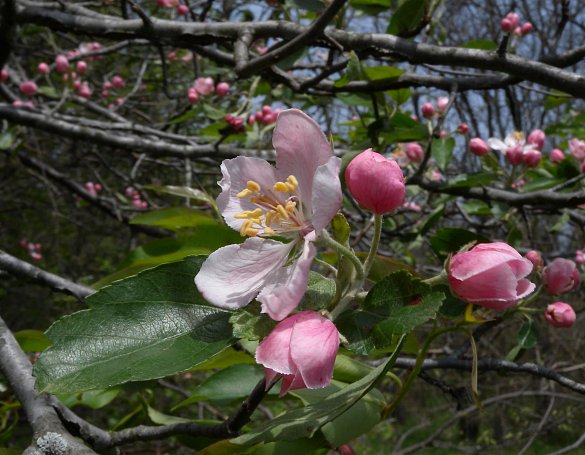
Clusters of 2-6 flowers develop from the tips of twigs and short lateral spurs. The pedicels of these flowers are ¾–1½" long and densely pubescent. Individuals flowers are 1¼–2" across; each flower consists of 5 light pink to nearly white petals, a green cup-shaped calyx with 5 teeth, 10-20 stamens with yellow anthers, and a pistil with 5 styles. The widely spreading petals are oval in shape, except they taper abruptly to become narrow at their bases. The calyx and its teeth are pubescent on both the exterior and interior surfaces; the teeth are linear-lanceolate to narrowly triangular in shape. The large flower buds are usually bright pink. The blooming period occurs during the late spring, lasting about 1-2 weeks. The diurnal flowers have a tendency to bloom at about the same time, and they are fragrant. Afterwards, fertile flowers will be replaced by fruits (pomes) that become 1–1¼" across at maturity; they are subgloboid to globoid in shape, except at their apices and bottoms, where they are indented. Mature fruits are greenish yellow with waxy exteriors, while their interiors are fleshy, firm, and white; each fruit contains up to 10 seeds. The flavor of mature fruits is sour and bitter. The seeds are dark-brown, flattened, and tear-drop shaped. The root system is woody and spreading; it is capable of developing clonal offsets from underground runners, especially when this woody plant has been top-killed by fire or some other catastrophe.
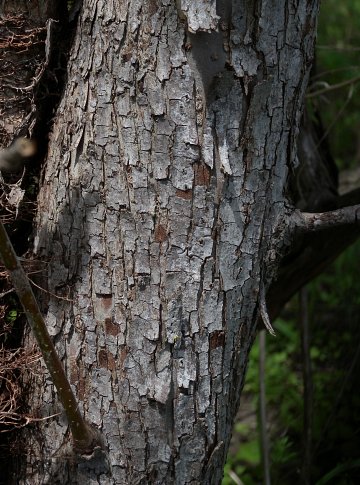
Cultivation: The preference is full or partial sun, moist to mesic conditions, and soil containing loam, clay-loam, or some rocky material. Like other apples and crab apples (Malus spp.), this woody plant is vulnerable to many disease organisms and insect pests. Nonetheless, if conditions are favorable, it can be long-lived, exceeding 50 years of age.
Range & Habitat: The native Prairie Crab Apple occurs in almost all counties of Illinois, where it is occasional (see Distribution Map). Populations of this species have declined because of habitat destruction. It is largely endemic to the midwestern United States (upper Mississippi valley), although widely scattered populations of this species occur further south. Habitats include open woodlands, savannas, thickets, woodland borders, limestone glades, prairies, hill prairies, semi-open areas along streams, edges of pastures and fields, fence rows, and powerline clearances in wooded areas. Prairie Crab Apple requires some disturbance in order to establish itself and thrive, although excessive disturbance will eliminate it.
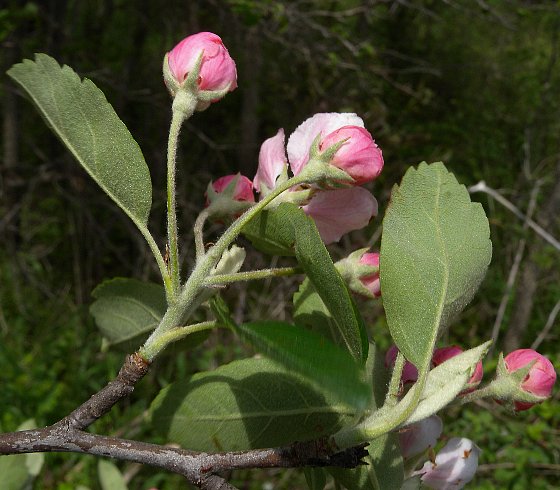
Faunal Associations: The value of Prairie Crab Apple to various kinds of wildlife is quite high. The nectar and pollen of the large flowers probably attract insects that are very similar to the pollinating insects of Wild Crab Apple (Malus coronaria), which includes honeybees, bumblebees, and other long-tongued bees; they are probably the primary agents of cross-pollination. Other visitors of the flowers include smaller bees, butterflies, and skippers (Robertson, 1929; Wilhelm & Rericha, 2017). A variety of insects feed destructively on the foliage, fruit, flowers, wood, and plant juices of crab apples. These insects include the larvae of wood-boring beetles, weevils, scarab beetles, plant bugs, aphids, leafhoppers, treehoppers, armored scales, mealybugs, larvae of sawflies, larvae of many moths, and larvae of a butterfly, the Striped Hairstreak (Satyrium liparops). The Apple Rust Mite (Aculus schlechtendali) usually feeds on leaf undersides of these shrubs (Cranshaw, 2004). Another notorious insect that is found in the fruits of apples and crab apples is the larvae of a fruit fly, the Apple Maggot (Rhagoletis pomenella). The Insect Table has a more complete of these species.
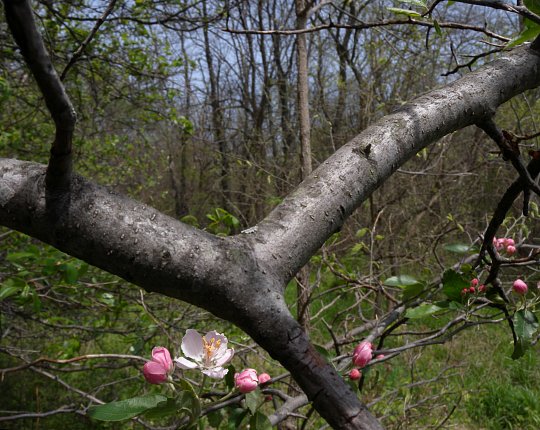
The fruits of Prairie Crab Apple, other crab apples, and the cultivated apple are sources of food to many mammals and birds. Mammals that eat these fruits include the American Black Bear, Gray Fox, Red Fox, Opossum, Raccoon, Striped Skunk, Groundhog, Fox Squirrel, and White-tailed Deer (Martin et al., 1951/1961; Kurz, 2004). By eating the fruits, these mammals spread the seeds of these woody plants to new locations (Myers et al., 2004). The White-tailed Deer also browses on the twigs and foliage, while the Cottontail Rabbit sometimes gnaws on the bark of saplings during the winter (Sotala & Kirkpatrick, 1973; Haugen, 1942).

Depending on the species, various birds feed on the buds and fruits of the Prairie Crab Apple, other crab apples, and the cultivated apple. For example, the Ruffed Grouse, Purple Finch, Evening Grosbeak, and White-throated Sparrow eat the buds, while the Northern Cardinal, Baltimore Oriole, Orchard Oriole, Common Grackle, Bobwhite Quail, Ring-necked Pheasant, Red-bellied Woodpecker, Hairy Woodpecker, Carolina Parakeet (now extinct), Monk Parakeet, and European Starling peck at the fruits (DeGraaf, 2002; Martin et al., 1951/1961; DeVore et al., 2004; Snyder, 2004). Because these woody plants, including the Prairie Crab Apple, are often densely branched and sometimes thorny, they provide good protective cover and nesting habitat for the Blue Jay, Orchard Oriole, Gray Catbird, Northern Mockingbird, Ruby-throated Hummingbird, American Robin, Eastern Kingbird, and Red-eyed Vireo (DeGraaf, 2002). Woodpeckers and other insectivorus birds also benefit from the large variety of insects that these woody plant attract.
Photographic Location: Edge of a woodland along a roadside in Champaign County, Illinois.
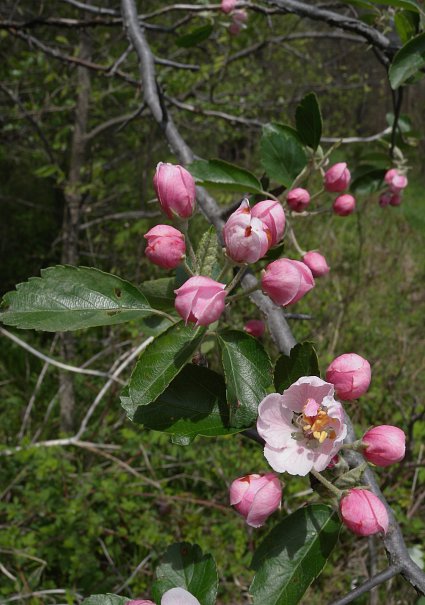
Comments: Prairie Crab Apple (Malus ioensis) is one of three native crab apples (Malus spp.) in Illinois. A second native species, Wild Crab Apple (Malus coronaria), is very similar in overall appearance, except that its leaves, young shoots, calyces, ovaries, and pedicels are hairless. This latter species has a more eastern distribution than Prairie Crab Apple. These two native crab apples differ from many introduced crab apples from Eurasia by having leaves with shallow lobes and greenish yellow fruits that exceed ¾" across. They are also more likely to have thorns along their branches than these non-native species. A third native species, Southern Crab Apple (Malus angustifolius), is smaller in size than the preceding native crab apples, and its leaves are more narrow in shape. In Illinois, this crab apple is found in the southern section of the state. The flowers of native crab apples are large, fragrant, and showy during the short period when they bloom during the spring. They are parent species of some crab apple cultivars that have been developed as ornamental plants for landscapes. For example, Bechtel's Crab Apple is a double-flowered cultivar that has Prairie Crab Apple as a parent. In the past, the fruit of Prairie Crab Apple was used to make apple jelly, cider, and vinegar.